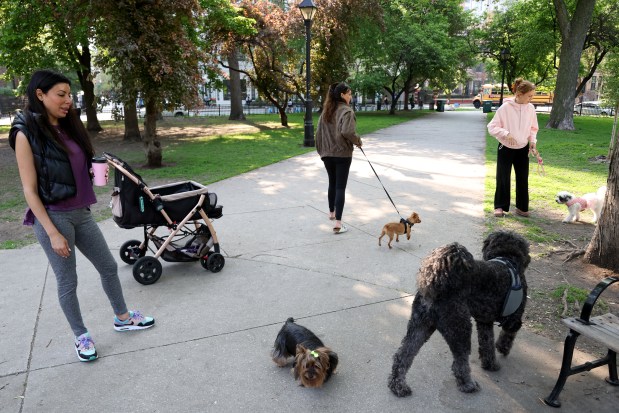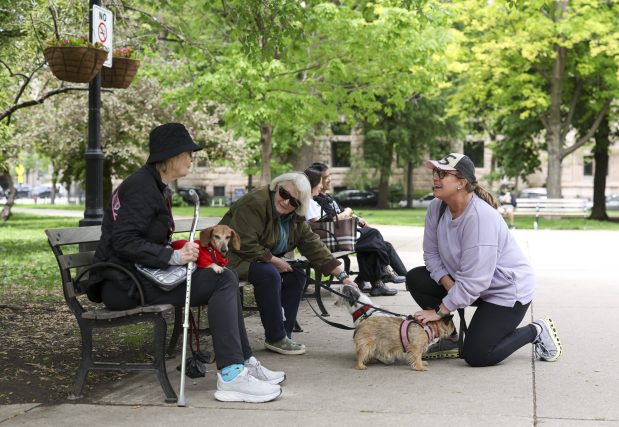Since its inception in 1842, Washington Square Park has seen its fair share of eras.
As the oldest park in Chicago, it was the landing spot for many people who lost their homes after the Great Chicago Fire of 1871. The space earned the name “Bughouse Square” in the early 1900s when people would come to the park to stand on soapboxes and crates to give long lectures about their theories, passions and ideologies.
Now, the Near North Side’s nearly 3-acre landmark park is frequented year-round by residents and visitors alike — even in the bitter wintertime when the foliage is dead and the ground is snowed over.
But like any green space, the square needs its maintenance and upkeep. City officials say that in recent years, the park’s grass has significantly deteriorated and needs to be aerated and seeded. The original plan, initiated by the Washington Square Park Advisory Council, was to close off all four grassy quadrants from September 2025 to spring 2026, making those areas inaccessible to residents for nearly eight months.
But for the residents of the neighborhood — particularly the dog owners — that plan felt disrespectful.
“I was shocked,” Nicole Barron, a local resident, said. “I’m here two to three times a day. I have a dog and we don’t have an outdoor yard, so this is our only outdoor space I can bring my dog.”
The fervent pushback from the neighbors appeared to catch the city by surprise. At a May 14 meeting at the Newberry Library, over a hundred people packed the room to advocate for the city to leave some grassy areas open while the city completes its beautification plan. The city changed course after the meeting and says it will take a phased approach to the aerating and seeding, scheduled to begin this fall.
“Washington Square Park has a formal architectural design that has allowed the Park District to work on one quadrant at a time for the past several years,” Michele Lemons, spokesperson for the Chicago Park District, said. “We intend to continue this approach this fall by closing access to sections of the park to aerate and seed to restore the park’s green areas. This will allow public access to sections of the park while other sections undergo restoration work.”
Lemons said cost for materials and labor are absorbed in routine park operating expenses, but did not respond to a question how much the project will cost overall.
But the threat of the park’s closure, even if only temporary, seemed to spark a sense of unity in the neighborhood, reminding dog owners, parkgoers and neighboring schools what the historic park means to them and the community.
“People have been calling me, like, ‘the girl that spoke at the dog meeting,’ and like recognizing me at the Starbucks nearby,” Courtney Clay, who frequents the park with her cocker spaniel, said. “And they’ll say things like, ‘Thank you for saving our park.’”
It is also a reflection of how the city’s oldest park, which served as the site of Chicago’s first gay pride march, has evolved over the years.
The park was deeded in 1842 by developers eager to boost land values in the area. It was at first surrounded by the large homes of the well-to-do, even after the 1871 fire leveled most of the nearby buildings.
Eventually, after the wealthy had moved to the north and east, it became a gathering place for those who lived in nearby rooming houses, hotels and small apartments. And many of those people liked to get on soapboxes and speak their minds. Some famous folks were attracted to this free speech oasis, such people as Carl Sandburg, Emma Goldman and Eugene V. Debs. Others were anonymous anarchists, dreamers, poets, preachers and lunatics.
“Washington Square Park is a special place, but it’s not a unique story about how green spaces evolve,” said Taylor Evans Ghosal, who worked on a documentary about the park’s history. “Green spaces and parks in general, they evolve. They evolve and change to fit the communities that surround them, and I think they’re just a really interesting microcosm of their community.”
Six Loyola University students have captured the magic of Bughouse Square, the city’s oldest park
That was a sentiment echoed by neighbors who frequent the park, some of whom emphasized that the park was not always a gathering place for the immediate community.
“When I came here, there really wasn’t a park like it is now. It was pretty scary. It had a lot of trees, but it did not have a fence, and it wasn’t really maintained,” said Mary Lou Sydel, who moved to the area in 1985. Sydel, who is part of the Washington Square Park Advisory Council, also noted that when she first moved to the park, it was not frequented by her neighbors.
In the 1990s, Washington Square Park was given landmark status and more people started to invest in the park to make it a more welcoming space. After the pandemic, Sydel noticed a boom in people using the park as a gathering space — particularly those with dogs. Now, nearly every day between 4 and 6 p.m., Sydel finds dozens of people enjoying the space and frequenting it to play with dogs in particular.
Some of her neighbors say that if it were not for Washington Square Park, they would have left the area long ago. That was the case for Rhonda Sanderson, a longtime resident who felt herself become more involved with her neighborhood during the pandemic when she started frequenting the park more.
“If there weren’t the dogs at that park, it would not have any kind of atmosphere like it has. It is joyous,” Rhonda Sanderson said. “People stop their cars to watch dogs play. Tourists walk through here … and they just go, ‘Oh my God.’ When they sit down, they’re so fascinated with the interaction of all of us with the dogs, how we’re all friendly and busy.”

At the same time, the proliferation of dogs has caused some tensions in the park, with some neighbors citing issues with off-leash dogs, torn-up grass and a general frustration with how the dogs appear to take over the space at times.
“I’m a dog owner, and I get it. I want to have a place to let my dog run free, but Washington Square Park is not a dog park,” said Willa Lang, executive director of the Chicago Parks Foundation. Lang emphasized that due to the park’s landmark status, it is not possible to make the area a dog park.
“Off-leash dog activity significantly contributes to turf damage,” said Lemons, spokesperson for the Park District. “The Chicago Park District Code states that domestic animals must be continuously restrained by a leash not exceeding six feet in length, except in areas designated as ‘Dog Friendly Areas.’”
Dog owners who violate leash laws are subject to a $300 fine, according to the city’s municipal code. If the violation results in “severe injury” to another person, the fine could run up to $10,000.
That tension came out at the May 14 meeting, which some owners say have prompted them and others to be more mindful about their behavior at the park.
“Everyone’s trying to get along and be mindful that when there’s children out there, the dog should be on the leash,” Brian Berg, a local resident who helped get the word out about the initial closure plan, said. “And so I think everyone’s trying to do better, and everybody’s got a stake in their park. And I think that’s, as a result of being listened to, that’s one of the positives that comes out of that, too.”



